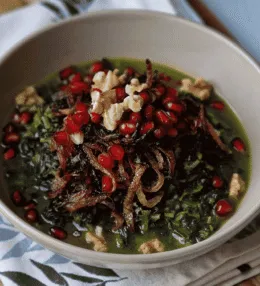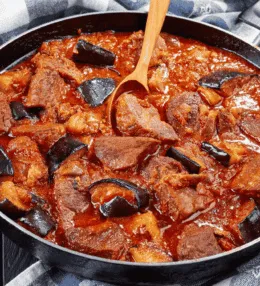
- View
Table of Contents
ToggleYuba is tofu skin, a delicate sheet that forms on warm soy milk. It folds like silk, tastes clean yet savoury, and slips easily into daily cooking. You can eat it fresh and supple, dried and chewy, or gently fried for crisp edges. Simple seasoning lets its gentle bean sweetness shine.
In Kyoto’s traditional restaurants, chefs present yuba with reverence, understanding that this ingredient represents a meditation on simplicity itself. What appears as mere wisps of pale film actually contains layers of culinary history and cultural significance.
Western diners might find themselves puzzled at first encounter. Yuba doesn’t announce itself with bold flavours or striking colours. Instead, it whispers rather than shouts, inviting you to notice its subtle sweetness and silken texture that dissolves on the tongue.
This quietness is precisely what makes yuba so compelling. In a world where food often competes for attention, yuba asks you to slow down and pay attention to nuance. It challenges you to appreciate something delicate and fleeting.
Want to dive deeper into Japanese Cuisine? Don’t miss our post on 26 Traditional Japanese Foods to Try
What Is Yuba?
Yuba forms when soy milk is gently heated, creating a thin protein film on the surface. This delicate layer gets carefully lifted away, revealing another skin forming beneath. The process continues, yielding sheet after gossamer sheet of tofu skin.
The name itself varies across regions. In Kyoto, people call it yuba, whilst Tokyo residents often say yuba or occasionally refer to it as soymilk skin. Chinese cuisine has its own version called doufu pi or tofu skin.
Fresh yuba, known as nama yuba, offers an entirely different experience from its dried counterpart. It arrives soft and pliable, with a custardy quality that feels luxurious against the palate. This version must be consumed quickly, within a day or two of production.
Dried yuba keeps for months and requires rehydration before use. Once softened in water, it becomes pliable again, ready to be wrapped around other ingredients, added to soups, or transformed into elaborate vegetarian dishes.
Some producers create yuba sticks by gathering the sheets whilst still warm and twisting them into irregular shapes. These knobby forms add textural interest to hot pots and braised dishes, soaking up surrounding flavours beautifully.
Ingredients and Taste
The ingredient list for yuba couldn’t be more straightforward: soybeans and water. That’s genuinely all you need to create this remarkable food. The quality of these two components, however, makes an enormous difference in the finished product.
Premium yuba begins with carefully selected soybeans, often organic varieties chosen for their protein content and natural sweetness. The beans get soaked, ground into a slurry, then strained to produce pure soy milk without any additives or stabilisers.
The taste of fresh yuba surprises people expecting something bland or austere. Instead, you encounter a gentle sweetness, almost creamy, with a clean finish that doesn’t linger heavily. It tastes unmistakably of soybeans yet refined and concentrated.
Texture matters as much as flavour here. Fresh yuba yields immediately when you bite into it, melting across your tongue with barely any chewing required. The sensation resembles very soft custard, though without any heaviness or richness.
Dried yuba, once rehydrated, develops a slightly chewier quality whilst retaining that characteristic silkiness. It absorbs broths and sauces readily, making it an excellent vehicle for other flavours without losing its own identity completely.
When served cold with nothing but a dab of wasabi and a splash of soy sauce, fresh yuba allows you to appreciate its pure essence. The wasabi’s heat and the soy’s umami complement rather than compete, highlighting the subtle bean flavour.
A Taste of History
Yuba’s story begins with the spread of Buddhism throughout Japan during the 8th century. Monks following strict vegetarian diets needed protein sources, and tofu along with its byproducts became essential to temple cuisine known as shojin ryori.
Kyoto, as the ancient imperial capital and a centre of Buddhist learning, became particularly associated with yuba production. The city’s pure water and abundance of temples created ideal conditions for this delicate craft to flourish over centuries.
Temple cooks elevated yuba from simple sustenance to an art form. They developed countless preparations, from yuba sashimi served raw and cold to elaborate simmered dishes where the tofu skin wraps seasonal vegetables in elegant bundles.
During the Edo period, yuba production expanded beyond monastery walls. Specialist shops opened in Kyoto’s Gion district, supplying both temples and wealthy households. These artisans refined their techniques, learning to create increasingly thin and uniform sheets.
The Meiji era brought challenges as Japan modernised rapidly and traditional foods fell out of favour. Yet yuba endured, protected by Kyoto’s fierce pride in its culinary heritage and the continued practice of temple cuisine throughout the country.
Today, yuba enjoys renewed appreciation both in Japan and internationally. Vegetarian and vegan diners prize it as a protein source, whilst chefs value its versatility and elegance. Modern producers use temperature controlled equipment, yet the fundamental process remains unchanged.
How to Make Yuba (Tofu Skin)
Yuba, the delicate skin formed on the surface of heated soy milk, is a treasured element of traditional Japanese cuisine. Silky and subtly flavoured, it embodies the elegance of simplicity. Making yuba requires patience and a gentle hand, but the result is a rewarding culinary experience. See the recipe card at the bottom for printable directions
Ingredients
- 1 litre unsweetened soy milk (high protein, around 10% solids)
- 1 tbsp water (for adjusting consistency if needed)
- Soy sauce, for dipping (optional)
- Wasabi or grated ginger, for serving (optional)
Cooking Instructions
Step 1: Prepare the soy milk
Pour the soy milk into a wide, shallow pan such as a stainless steel sauté pan or a traditional yuba pan. Avoid non-stick surfaces, as the skin forms better on metal. Place the pan over very low heat to prevent scorching.
Step 2: Heat gently
Warm the soy milk until small bubbles form around the edges but do not allow it to boil. The ideal temperature is about 80°C. At this point, the protein begins to coagulate and a thin film forms on the surface.
Step 3: Form the yuba skin
Let the soy milk sit undisturbed for about 5 to 7 minutes. A smooth, elastic skin will begin to form. Gently touch it with chopsticks or your fingertips to test its firmness. It should lift slightly without tearing.
Step 4: Lift the first sheet
Once the yuba skin appears firm and slightly translucent, use a pair of chopsticks to lift it carefully from one edge, pulling upwards in a slow, steady motion. Allow any excess soy milk to drip back into the pan.
Step 5: Drain and dry slightly
Hang the lifted yuba over a rod or rest it on a clean edge for a few seconds to drain. This helps the sheet firm up and become easier to handle. You can also lay it flat on a tray lined with parchment.
Step 6: Repeat the process
Allow a new film to form on the surface of the soy milk. Each batch takes about 5 to 7 minutes. Repeat until most of the soy milk has been used. You should get 6 to 8 sheets from one litre, depending on thickness.
Step 7: Cool and set
Place the collected sheets in a single layer on a plate to cool slightly. If you prefer soft yuba, keep them moist. For firmer sheets, let them air dry longer or chill briefly in the refrigerator.
Step 8: Serve fresh
Serve the fresh yuba with a small dish of soy sauce and a dab of wasabi or grated ginger. It can also be added to soups or rolled around vegetables for an elegant appetiser.
Step 9: Store any leftovers
If not serving immediately, wrap the yuba in cling film or place it in an airtight container. Store in the fridge for up to two days. Gently steam or soak in warm water to soften before using again.
Step 10: Enjoy the tradition
Enjoy the delicate layers of yuba as they melt lightly on the tongue, carrying the subtle sweetness of soy. It’s a reminder that the simplest ingredients often hold the deepest flavour.
Variations and Substitutions
- Soy milk: Use fresh, unflavoured soy milk with no additives. Homemade soy milk works best for authentic texture.
- Dipping sauce: Replace soy sauce with ponzu for a citrusy note.
- Flavour twist: Infuse the soy milk with kombu (kelp) for a touch of umami before heating.
- Dried yuba: If fresh yuba is unavailable, dried yuba sheets can be rehydrated in warm water and used in stews or stir fries.
Cooking Tips for Perfect Yuba
- Keep the soy milk at a stable low temperature to form an even skin.
- Do not stir the milk once heating begins; stillness is key.
- Choose a wide pan to maximise surface area for larger yuba sheets.
- Freshly made yuba tastes best served within hours of preparation.
- If the skin tears easily, lower the temperature slightly and allow more time for setting.
How to Store and Reheat
Storing Fresh Yuba
Fresh yuba demands careful handling and quick consumption. Keep it refrigerated in its original packaging, typically a container filled with liquid to prevent drying. Use within one to two days of purchase for optimal texture and flavour.
If you must extend its life slightly, ensure the yuba remains completely submerged in fresh water, changing the liquid daily. However, the quality deteriorates noticeably after the first day, losing that prized silky texture gradually.
Never freeze fresh yuba. The ice crystals damage the delicate protein structure irreversibly, leaving you with a grainy, unpleasant texture upon thawing. This ingredient simply isn’t designed for long term storage in its fresh state.
Storing Dried Yuba
Dried yuba offers far more flexibility. Keep it in an airtight container in a cool, dark cupboard, where it will remain usable for several months. Some varieties last up to a year when properly stored away from moisture and heat.
Check occasionally for any signs of mould or rancidity, though properly dried yuba rarely develops problems. The sheets should remain brittle and snap cleanly when bent. Any flexibility suggests moisture infiltration and shortened shelf life ahead.
Rehydrating Dried Yuba
Bring dried yuba back to life by soaking it in lukewarm water for 20 to 30 minutes. The sheets will soften and become pliable, ready for whatever preparation you have planned. Drain thoroughly before using.
Hot water speeds the process but can make the yuba too soft and prone to tearing. Cold water works but takes considerably longer. Room temperature or slightly warm water hits the sweet spot for rehydration without compromising texture.
Reheating Prepared Yuba
Yuba dishes often taste better at room temperature or gently warmed rather than piping hot. If reheating is necessary, use low gentle heat to avoid toughening the delicate skin. A quick dip in simmering broth works well.
Microwaving tends to create rubbery spots and uneven heating. If you must use a microwave, do so in short five to ten second bursts at medium power, checking frequently to prevent overcooking that ruins the texture completely.

Japanese Yuba (Tofu Skin)
Ingredients
- 1 litre unsweetened soy milk high protein, around 10% solids
- 1 tbsp water for adjusting consistency if needed
- Soy sauce for dipping (optional)
- Wasabi or grated ginger for serving (optional)
Instructions
- Pour the soy milk into a wide, shallow pan such as a stainless steel sauté pan or a traditional yuba pan. Avoid non-stick surfaces, as the skin forms better on metal. Place the pan over very low heat to prevent scorching.
- Warm the soy milk until small bubbles form around the edges but do not allow it to boil. The ideal temperature is about 80°C. At this point, the protein begins to coagulate and a thin film forms on the surface.
- Let the soy milk sit undisturbed for about 5 to 7 minutes. A smooth, elastic skin will begin to form. Gently touch it with chopsticks or your fingertips to test its firmness. It should lift slightly without tearing.
- Once the yuba skin appears firm and slightly translucent, use a pair of chopsticks to lift it carefully from one edge, pulling upwards in a slow, steady motion. Allow any excess soy milk to drip back into the pan.
- Hang the lifted yuba over a rod or rest it on a clean edge for a few seconds to drain. This helps the sheet firm up and become easier to handle. You can also lay it flat on a tray lined with parchment.
- Allow a new film to form on the surface of the soy milk. Each batch takes about 5 to 7 minutes. Repeat until most of the soy milk has been used. You should get 6 to 8 sheets from one litre, depending on thickness.
- Place the collected sheets in a single layer on a plate to cool slightly. If you prefer soft yuba, keep them moist. For firmer sheets, let them air dry longer or chill briefly in the refrigerator.
- Serve the fresh yuba with a small dish of soy sauce and a dab of wasabi or grated ginger. It can also be added to soups or rolled around vegetables for an elegant appetiser.
- If not serving immediately, wrap the yuba in cling film or place it in an airtight container. Store in the fridge for up to two days. Gently steam or soak in warm water to soften before using again.
- Enjoy the delicate layers of yuba as they melt lightly on the tongue, carrying the subtle sweetness of soy. It’s a reminder that the simplest ingredients often hold the deepest flavour.
Nutrition
You May Also Like






